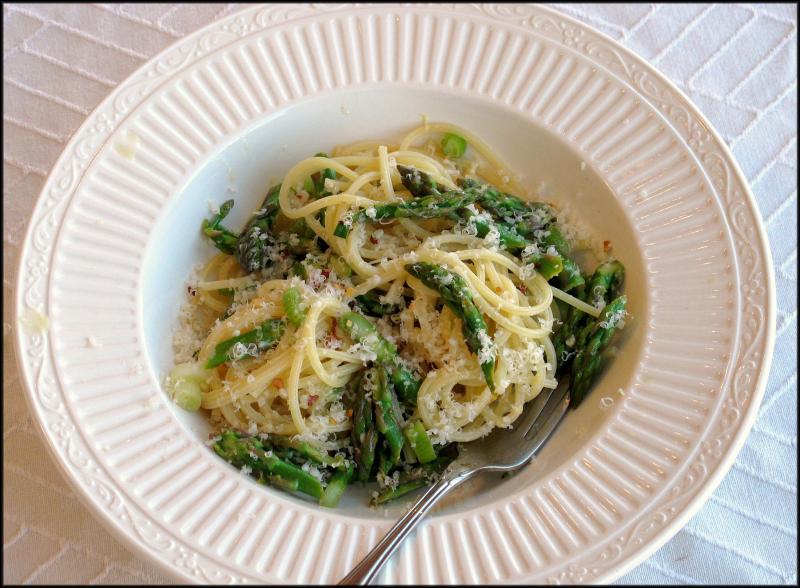Asparagus & lemon pasta dish welcomes spring with zing!
To celebrate the return of daylight saving time, I wanted to serve something with bright spring flavors. So, I turned to an ingredient that heralds the annual arrival of warmer weather – asparagus. Local crops usually begin to appear in mid-March with a harvest lasting through mid-June. Anything you’ve found at the market through the winter months has certainly come from farther away than Sussex County or nearby Maryland farms.
One of the basic misconceptions about asparagus is the significance of its size, specifically its thickness. Many believe the thinner the stalk, the more tender it will be. It’s actually the opposite. The smaller, younger crowns which produce thinner stalks are expending energy to make sure their new stalks will stand upright. This means most of their content is crude fiber.
The older, larger crowns that produce thicker stalks are more mature and don’t need as much cellulose, instead thickening their spears with softer, soluble fiber. Thin stalks of asparagus have more in common with celery. You can see this if you cut the end of a spear: the thin one will have an outer green ring and almost no center mass; the thicker one will also have the green outer ring, but a larger, soft center.
As you may guess, the thinner stalks will be tougher to chew, although the flavors of each type will be similar. No matter whether you opt for thin or thick, be sure to prepare asparagus as soon as possible after you bring it home. It will toughen the longer it sits, losing moisture as the sugars turn to starch. Left at room temperature, the spears develop woody tissue, which happens faster in thinner stalks.
The other flavor that I wanted to incorporate was lemon, which always adds bright, tart citrus notes. I browsed through several cookbooks looking for a pasta recipe featuring asparagus and lemon, finding a few I didn’t agree with in terms of their ingredients or approach. For example, some advised paring curls of lemon peel and adding them in long spirals. This didn’t seem a good idea, as it would add bitter inner pith. The approach I preferred was using lemon zest.
Another point of disagreement was the amount of lemon juice. Adding the juice of two lemons was far too much; one-half lemon was plenty. I also significantly reduced the amount of oil in which to sauté the asparagus. Extra virgin or not, two-thirds cup of oil is much more than necessary. I didn’t want to fish out garlic slices, so I opted to mince it.
And, I wanted another flavor element to balance the acidity of the lemon, so I added sliced green onions to the sauté step. You could use minced shallots, as well. The final change I incorporated was to stir in a generous half-cup of pasta water. It’s easier to dip out the water at the end of the cooking time rather than try to catch it as you drain the pasta through a colander.
The water will look a little cloudy and yellowish due to the starch it collected from the cooking pasta. This will add flavor, encourage the sauce to cling to the pasta, and also thicken the sauce. Here’s my recipe for pasta with asparagus and lemon, as well as one for an asparagus quiche to help you welcome spring.
Asparagus & Lemon Pasta
1/2 lb spaghetti
1/2 C pasta water
1 bunch asparagus
3 T olive oil
3 sliced scallions
1 minced garlic clove
zest of 1 lemon
2 T lemon juice
pinch red pepper flakes
1/2 C grated Parmesan
salt & pepper, to taste
Cook pasta in salted boiling water according to package directions for al dente. Before draining, reserve 1/2 C pasta water. Rinse asparagus and cut off top 3 inches at a deep diagonal; reserve stems for another purpose. Heat olive oil in a deep skillet. Add asparagus, scallions and garlic. Cook, stirring often, just until asparagus turns bright green. Stir in lemon zest, juice, red pepper and Parmesan cheese. Pour in pasta water and stir until thickened. Add drained spaghetti and toss to combine. Season to taste with salt and pepper. Serve garnished with additional Parmesan cheese. Yield: 2 to 3 servings.
Asparagus Quiche*
1 pastry shell
2 lbs asparagus
6 eggs
pinch salt
1/8 t white pepper
5 oz ricotta cheese
5 oz grated sharp Cheddar cheese
1 t thyme leaves
Preheat oven to 350 F. Bake the pastry shell until golden, about 15 minutes. Trim the tops from the asparagus, reserving the stalks for another use. Whisk the eggs with salt and pepper until smooth. Stir in ricotta, Cheddar and thyme, mixing to combine thoroughly. Add the asparagus tips and pour into baked pie shell. Bake until golden and set, about 40 minutes. Yield: 6 to 8 servings. *Adapted from Jamie Oliver’s Ultimate Veg.





















































